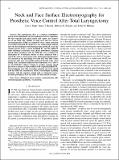Neck and face surface electromyography for prosthetic voice control after total laryngectomy
Author(s)
Stepp, Cara E.; Heaton, James T.; Rolland, Rebecca G.; Hillman, Robert E.
DownloadStepp-2009-Ieee Transactions on Neural Systems and Rehabilitation Engineering.pdf (1.394Mb)
PUBLISHER_POLICY
Publisher Policy
Article is made available in accordance with the publisher's policy and may be subject to US copyright law. Please refer to the publisher's site for terms of use.
Terms of use
Metadata
Show full item recordAbstract
The electrolarynx (EL) is a common rehabilitative speech aid for individuals who have undergone total laryngectomy, but they typically lack pitch control and require the exclusive use of one hand. The viability of using neck and face surface electromyography (sEMG) to control the onset, offset, and pitch of an EMG-controlled EL (EMG-EL) was studied. Eight individuals who had undergone total laryngectomy produced serial and running speech using a typical handheld EL and the EMG-EL while attending to real-time visual sEMG biofeedback. Running speech tokens produced with the EMG-EL were examined for naturalness by 10 listeners relative to those produced with a typical EL using a visual analog scale. Serial speech performance was assessed as the percentage of words that were fully voiced and pauses that were successfully produced. Results of the visual analog scale assessment indicated that individuals were able to use the EMG-EL without training to produce running speech perceived as natural as that produced with a typical handheld EL. All participants were able to produce running and serial speech with the EMG-EL controlled by sEMG from multiple recording locations, with the superior ventral neck or submental surface locations providing at least one of the two best control locations.
Date issued
2009-04Department
Harvard University--MIT Division of Health Sciences and TechnologyJournal
IEEE Transactions on Neural Systems and Rehabilitation Engineering
Publisher
Institute of Electrical and Electronics Engineers
Citation
Stepp, C.E. et al. “Neck and Face Surface Electromyography for Prosthetic Voice Control After Total Laryngectomy.” Neural Systems and Rehabilitation Engineering, IEEE Transactions on 17.2 (2009): 146-155. © 2009 IEEE.
Version: Final published version
Other identifiers
INSPEC Accession Number: 10560665
ISSN
1534-4320